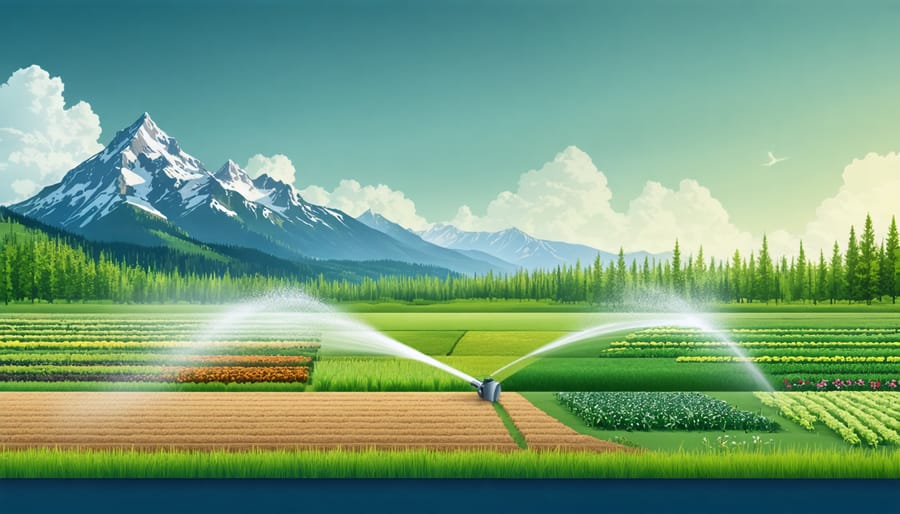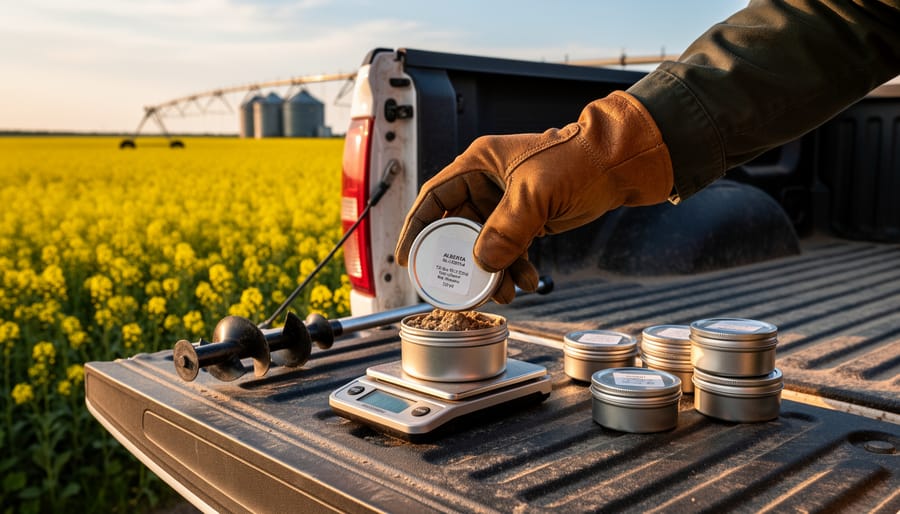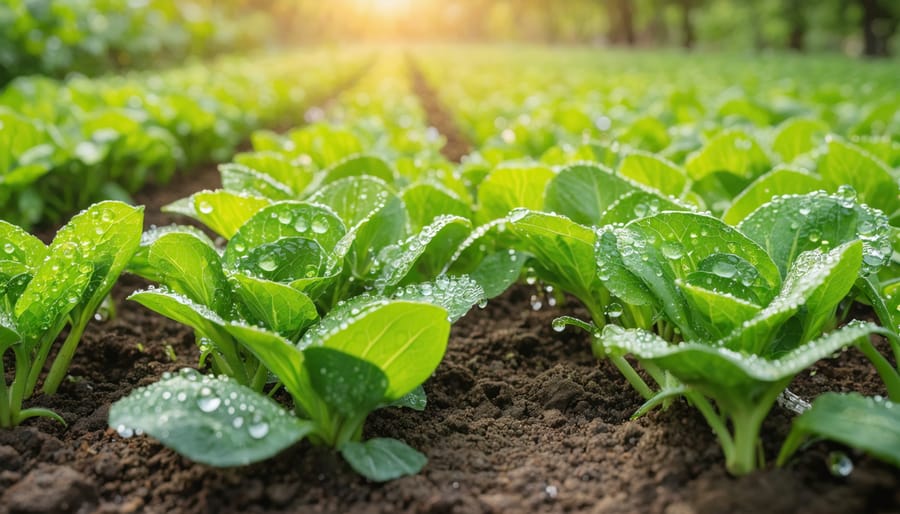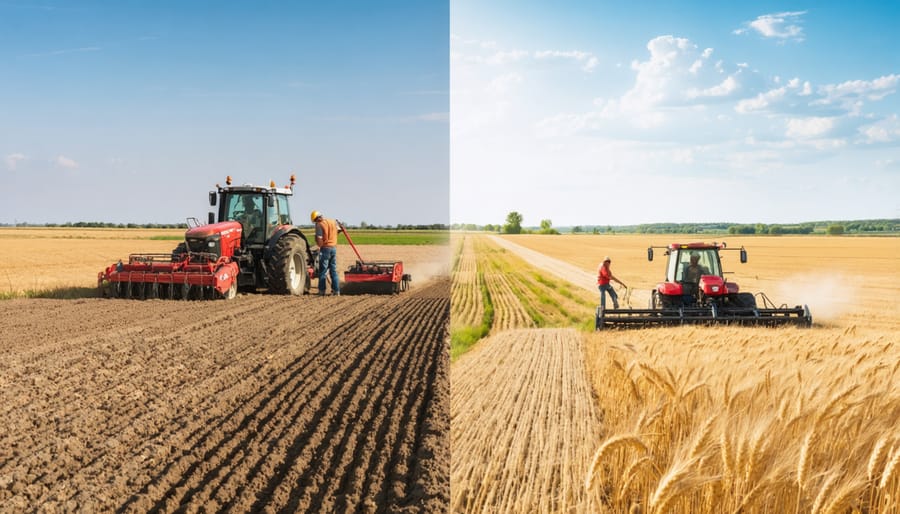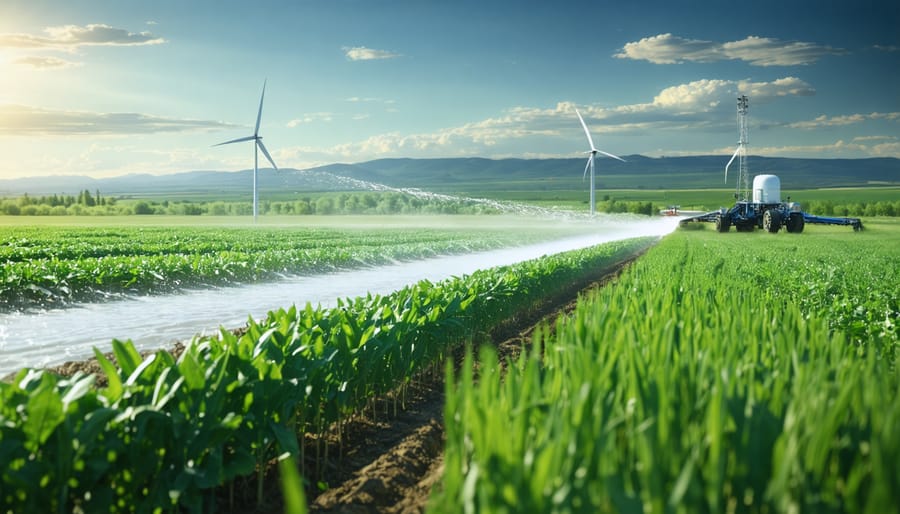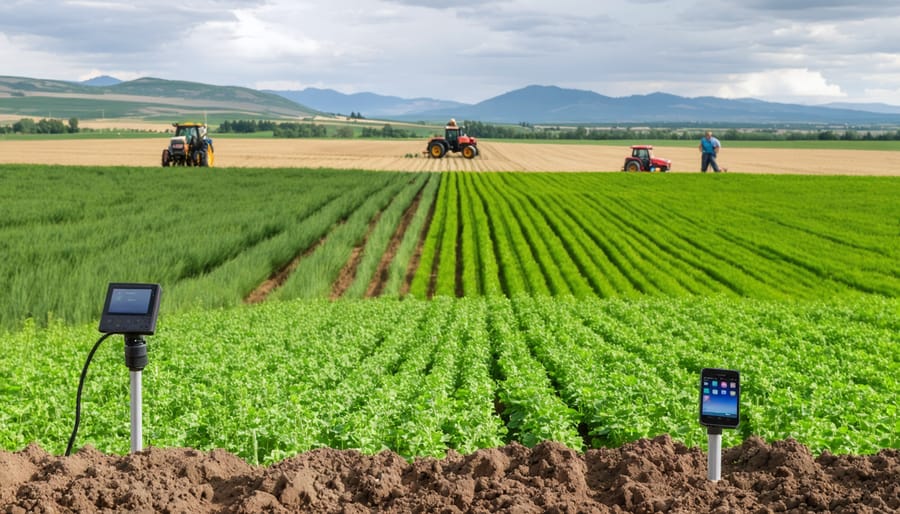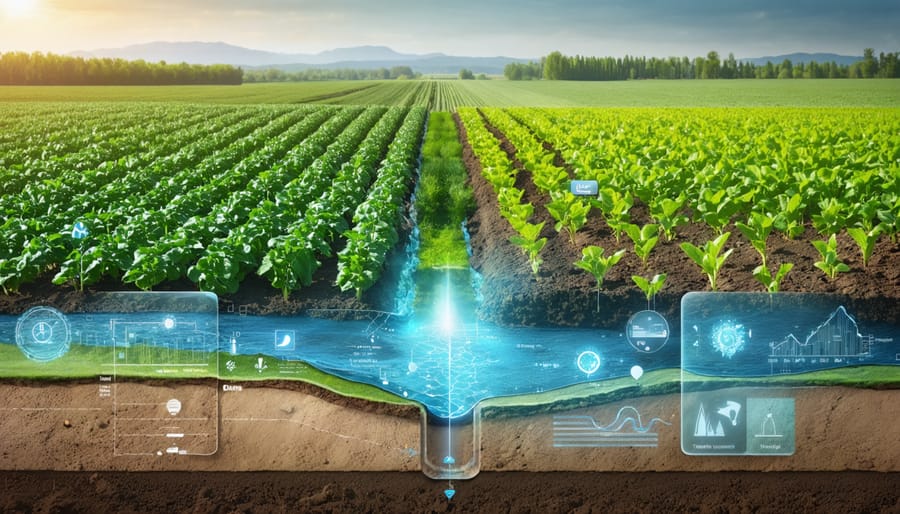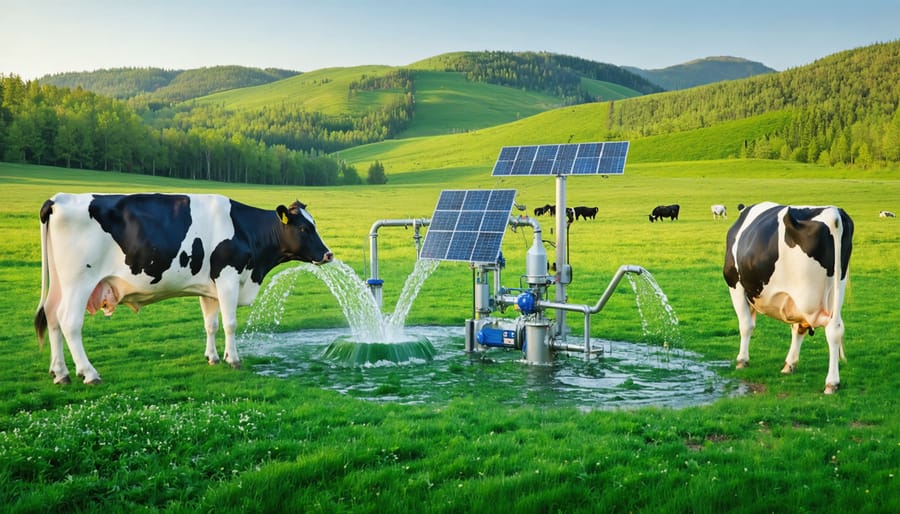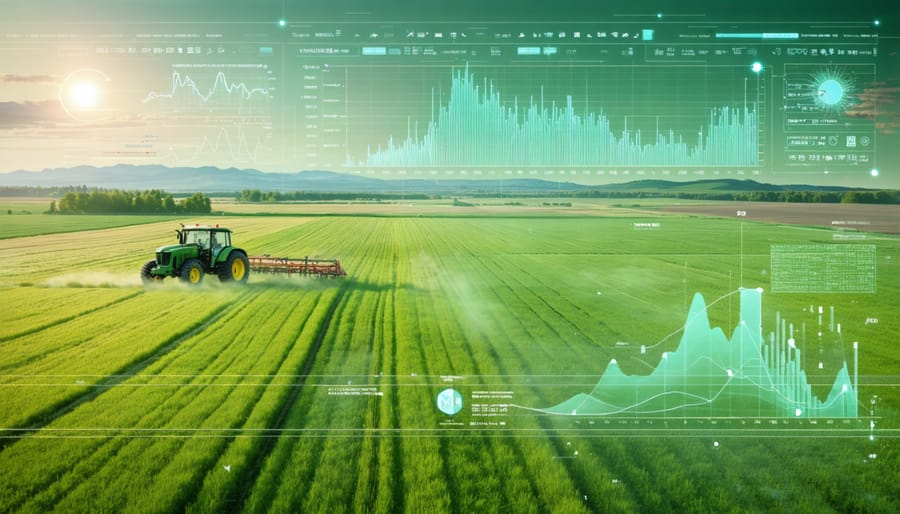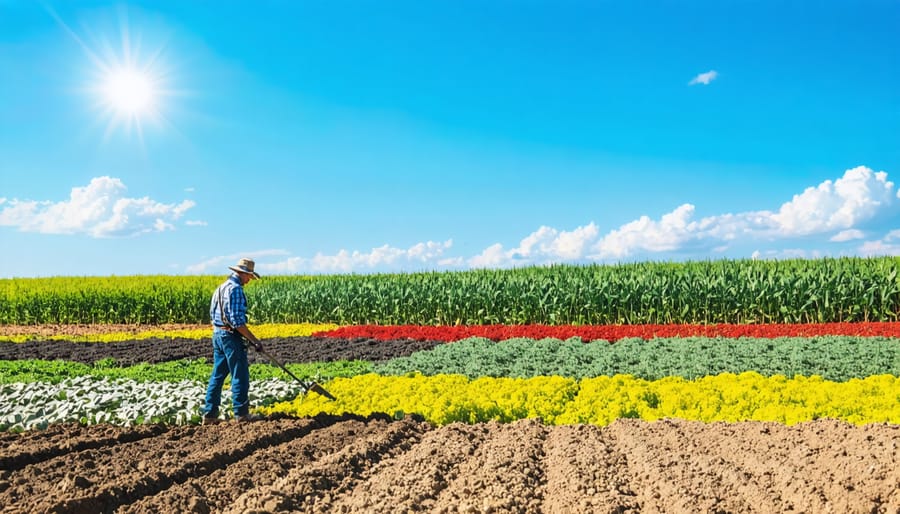Alberta’s climate demands swift adaptation from farmers facing increasingly unpredictable weather patterns. Monitor soil moisture levels weekly using precision agriculture tools to optimize irrigation schedules, reducing water waste by up to 30%. Implement proven drought adaptation strategies including cover cropping and reduced tillage practices, which have helped local producers maintain yields during dry spells. Recent data from Agriculture Alberta shows that farmers employing these methods saved an average of 200mm of soil moisture annually, while increasing organic matter content by 2%. Our changing provincial climate presents both challenges and opportunities – from longer growing seasons in the Peace Region to increased heat stress in Southern Alberta’s irrigation districts. Local success stories demonstrate that combining traditional knowledge with modern technology enables Alberta farmers to thrive despite shifting weather patterns, particularly in moisture-stressed regions where every drop counts.
Understanding Alberta’s Climate Patterns
Regional Climate Variations
Alberta’s agricultural landscape is divided into distinct growing zones that showcase remarkable climatic diversity. The Peace Region in the northwest experiences longer summer daylight hours but shorter growing seasons, making it ideal for cool-season crops like canola and wheat. Central Alberta’s parkland region benefits from moderate precipitation and rich black soil, supporting diverse crop production and mixed farming operations.
Southern Alberta’s prairie region, while typically drier, has extensive irrigation infrastructure that enables specialty crop production, including sugar beets and potatoes. The foothills zone along the Rocky Mountains receives higher precipitation and supports excellent grazing land for livestock operations.
Each zone presents unique opportunities and challenges for farmers. The Edmonton-area parkland typically receives 450-500mm of annual precipitation, while the Medicine Hat region in the southeast may see only 300mm. These variations influence crop selection, planting dates, and risk management strategies. Temperature fluctuations are equally significant, with spring frost dates varying by up to three weeks between southern and northern regions, requiring farmers to adapt their growing practices accordingly.
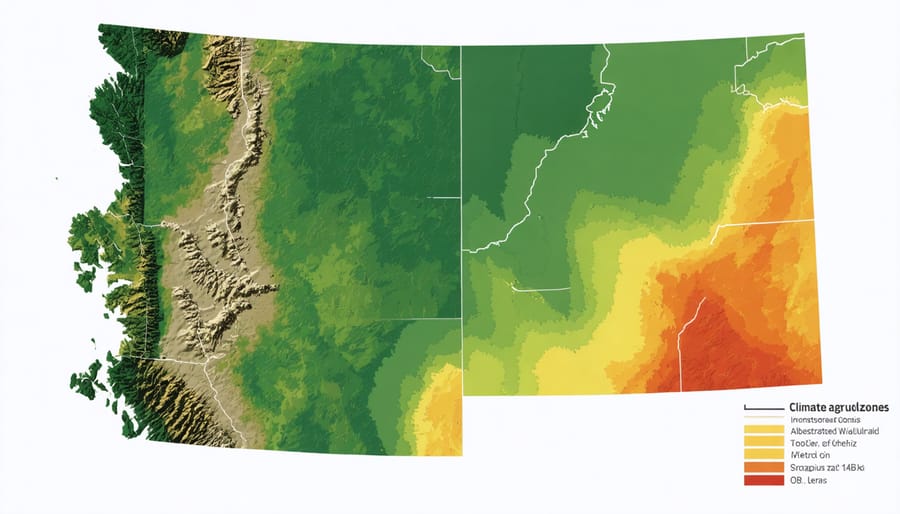
Climate Change Impact on Water Resources
Alberta’s farmers are experiencing significant shifts in their irrigation needs as climate change continues to impact water resource management across the province. Recent data shows that spring runoff patterns are becoming less predictable, with earlier melting of mountain snowpack affecting water availability during crucial growing periods. Many producers report needing to irrigate up to three weeks earlier than they did a decade ago.
Projections indicate that by 2050, Alberta’s agricultural regions may face a 10-15% increase in water demand due to higher temperatures and extended growing seasons. This change is particularly noticeable in traditional dryland farming areas, where producers are increasingly considering irrigation systems to maintain crop yields.
The South Saskatchewan River Basin, which supplies water to much of southern Alberta’s agricultural land, is experiencing increased pressure from both agricultural and urban demands. Farmers are adapting by implementing precision irrigation technologies and drought-resistant crop varieties to optimize water usage while maintaining productivity. These adaptations are becoming essential for sustainable farming operations in our changing climate.
Modern Irrigation Technologies for Alberta Farms
Precision Drip Systems
In Alberta’s increasingly variable climate, precision drip systems have emerged as one of the most innovative irrigation techniques helping farmers maximize water efficiency while maintaining crop yields. These systems deliver water directly to plant root zones through a network of tubes and emitters, reducing water waste by up to 60% compared to traditional irrigation methods.
Local farmers have reported significant success with drip systems, particularly in regions like Southern Alberta where water conservation is crucial. The systems work by releasing small amounts of water at regular intervals, maintaining optimal soil moisture levels while preventing water loss through evaporation and runoff. This precision approach not only conserves water but also helps prevent weed growth and reduces the risk of foliar diseases.
Modern drip systems in Alberta often incorporate smart technology, including soil moisture sensors and weather monitoring equipment. These components allow farmers to adjust water delivery based on real-time conditions, ensuring crops receive exactly what they need when they need it. Many systems can be controlled remotely through smartphone apps, making management more convenient and responsive.
Installation costs typically range from $2,500 to $5,000 per hectare, but provincial grants and water efficiency incentives can help offset these initial investments. The return on investment usually becomes apparent within 2-3 growing seasons through reduced water usage, lower energy costs, and improved crop quality. Local agricultural extension offices provide support and guidance for farmers interested in implementing these systems, including technical assistance and funding information.
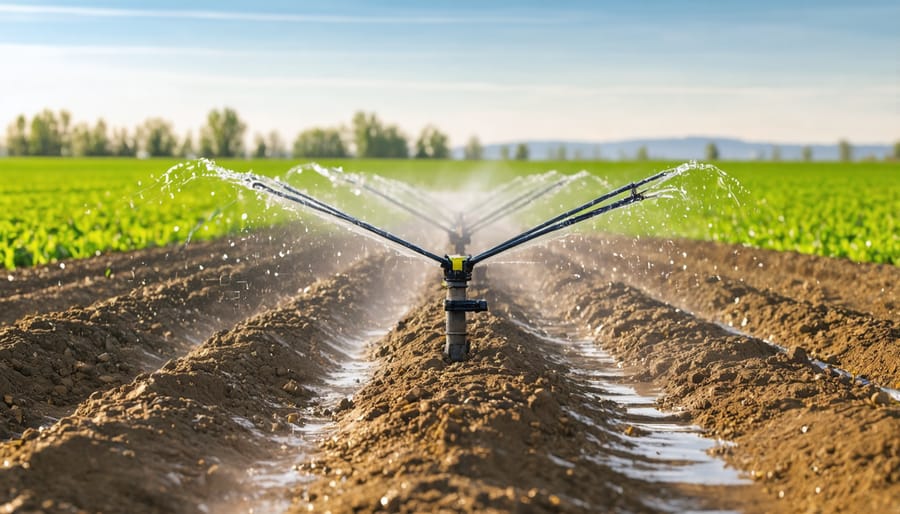
Smart Sprinkler Solutions
In Alberta’s variable climate, smart sprinkler solutions have become instrumental in optimizing water usage and crop yields. These automated systems combine weather monitoring technology with precision irrigation controls to deliver water exactly when and where it’s needed. Local farmers report water savings of up to 30% compared to traditional irrigation methods while maintaining or improving crop health.
Modern smart sprinkler systems incorporate soil moisture sensors, weather stations, and automated controls that can be managed through smartphone apps. These systems monitor real-time weather conditions, including temperature, humidity, and precipitation forecasts, automatically adjusting watering schedules to prevent over-irrigation during rainy periods or increasing water delivery during dry spells.
The Alberta Agriculture and Forestry department has documented successful implementations across the province, with particularly strong results in southern Alberta’s intensive farming regions. For example, the Henderson family farm near Lethbridge reduced their water consumption by 35% in their first season using smart irrigation technology, while reporting a 15% increase in crop uniformity.
Key features of these systems include zone-specific programming, allowing farmers to customize irrigation patterns based on soil type and crop requirements. Flow sensors detect leaks and blockages, preventing water waste and equipment damage. Some systems even integrate with provincial weather networks to access hyperlocal forecast data for more accurate irrigation planning.
While the initial investment ranges from $5,000 to $15,000 depending on field size and system complexity, many farmers recover costs through reduced water usage and labour savings within two to three growing seasons. Provincial rebate programs are available to help offset installation costs, making these systems increasingly accessible to Alberta’s agricultural community.
Real Farm Success Stories
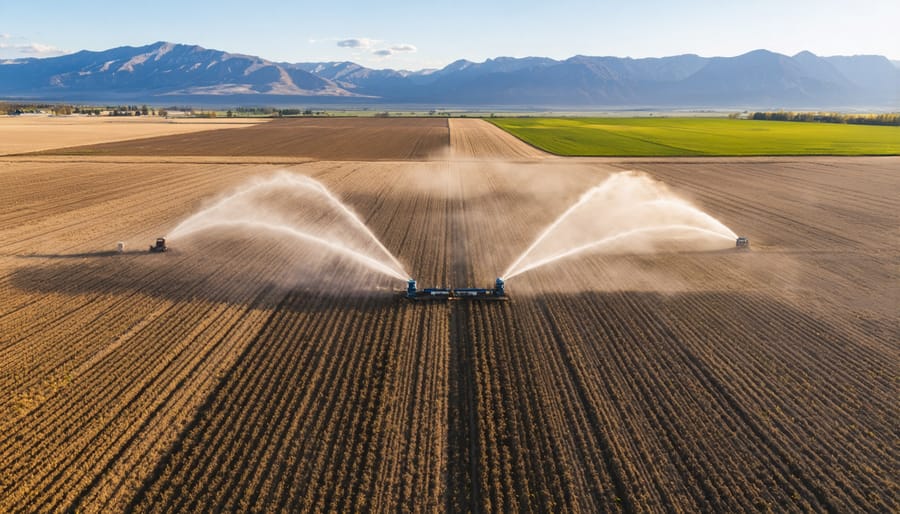
Southern Alberta Grain Farm Transformation
The Henderson family farm, located just outside of Lethbridge, stands as a testament to successful water conservation in Alberta’s evolving agricultural landscape. In 2018, facing increasingly unpredictable rainfall patterns, the Hendersons transformed their 2,000-hectare grain operation through innovative irrigation practices and soil management techniques.
By implementing precision irrigation systems and soil moisture monitoring technology, the farm reduced water usage by 40% while maintaining crop yields. The family installed soil sensors across their fields, providing real-time data about moisture levels at various depths. This information allows them to make informed decisions about when and how much to irrigate.
The Hendersons also adopted conservation tillage practices and introduced cover crops, which help retain soil moisture and improve organic matter content. These changes have increased their soil’s water-holding capacity by approximately 30%, making their operation more resilient during dry spells.
“The transformation wasn’t just about new technology,” explains Sarah Henderson. “It was about changing our whole approach to water management. We now treat every drop as precious resource.” The farm’s success has inspired neighboring operations, with twelve local farms adopting similar practices in the past two years.
The Henderson farm now serves as a demonstration site for the Alberta Irrigation Management Program, showing other farmers how water conservation can work in practical, profitable ways. Their annual water savings amount to roughly 100 million litres, proving that sustainable practices can coexist with productive farming.
Central Alberta Market Garden Innovation
The Knutson family farm, located 20 kilometers east of Red Deer, demonstrates how small-scale irrigation innovation can thrive in Central Alberta’s challenging climate. In 2019, Sarah and Mike Knutson transformed their traditional 4-hectare market garden into a model of water efficiency through the implementation of smart irrigation techniques.
Their system combines drip irrigation with soil moisture sensors, reducing water usage by 40% compared to their previous overhead sprinkler setup. The Knutsons installed a network of pressure-compensating drip lines that deliver water directly to plant roots, minimizing evaporation loss. They also integrated automated controls that respond to real-time soil moisture data, ensuring optimal water distribution throughout their diverse crop rows.
“We used to struggle with inconsistent produce quality during dry spells,” shares Sarah Knutson. “Now we’re seeing steady growth across all our vegetables, from root crops to leafy greens.” The system’s success has attracted attention from neighboring farms, with twelve local growers adopting similar approaches in the past two years.
The project required an initial investment of $15,000, but the Knutsons recovered these costs within two growing seasons through reduced water consumption and improved crop yields. Their market garden now produces 30% more vegetables using less water, proving that efficient irrigation can succeed in Alberta’s variable climate while supporting local food security.
Implementation Guidelines
Assessment and Planning
Begin your farm assessment by conducting a thorough evaluation of your current irrigation practices and water usage patterns. Document your existing water sources, infrastructure, and seasonal consumption rates. Consider tracking these metrics over at least one growing season to establish baseline data for measuring water efficiency improvements.
Create a detailed implementation plan that addresses your specific needs and challenges. Start by setting realistic goals for water conservation and crop productivity. List your available resources, including budget, equipment, and personnel. Consider consulting with local agricultural extension services or irrigation specialists who understand Alberta’s unique climate conditions.
Develop a timeline that accounts for seasonal changes and critical growing periods. Break down your plan into manageable phases, prioritizing improvements that offer the most immediate impact. Include regular monitoring and adjustment points to ensure your strategies remain effective.
Remember to factor in potential challenges such as drought periods, equipment maintenance, and staff training needs. Build contingency plans for extreme weather events, which are becoming more common in Alberta’s changing climate. Consider joining local farmer networks or cooperatives to share experiences and resources during implementation.
Your plan should also include a budget breakdown, potential funding sources, and expected return on investment calculations. Many Alberta farmers find that proper planning leads to significant water savings and improved crop yields within the first year of implementation.
Available Support and Resources
Alberta farmers have access to numerous support programs and resources designed to help them adapt to climate challenges. The Canadian Agricultural Partnership (CAP) offers grants of up to $50,000 for implementing climate-smart agricultural practices, including irrigation efficiency upgrades and soil conservation projects.
The Alberta Climate Information Service (ACIS) provides free, detailed weather data and forecasting tools specifically tailored to agricultural needs. Farmers can access real-time climate information, historical data, and seasonal predictions to make informed decisions about planting and harvesting schedules.
Technical assistance is available through Alberta Agriculture and Forestry’s network of specialists. These experts offer one-on-one consultations, conduct farm visits, and provide customized recommendations for climate adaptation strategies. The Agricultural Research and Extension Council of Alberta (ARECA) connects farmers with local applied research associations that conduct field trials and demonstrate new climate-resilient farming techniques.
Financial support is also available through the Environmental Stewardship and Climate Change Producer Program, which helps offset the costs of implementing greenhouse gas reduction practices. Local agricultural fieldmen and municipal districts provide additional resources, including workshops, equipment rentals, and networking opportunities with experienced farmers who have successfully adapted to climate challenges.
The Farm Energy and Agri-Processing Program offers rebates for energy-efficient equipment upgrades, while the Canadian Agricultural Strategic Priorities Program supports innovative projects that address climate-related challenges in the agricultural sector.
Alberta’s unique climate challenges present both opportunities and obstacles for our agricultural community, but through collaborative efforts and innovative approaches, we’re building a more resilient farming future. The evidence is clear: adapting to our climate conditions requires a combination of traditional wisdom and modern solutions, from improved irrigation systems to drought-resistant crop varieties.
Throughout Alberta’s farming regions, we’ve seen remarkable success stories of producers who’ve embraced climate-smart practices. These pioneers have demonstrated that sustainable agriculture isn’t just environmentally responsible – it’s economically viable. By implementing water conservation techniques, adopting precision agriculture, and utilizing seasonal forecasting tools, Alberta farmers are leading the way in climate adaptation.
The path forward requires continued commitment from our agricultural community. Consider starting small with one or two climate-adaptive practices on your farm. Connect with local agricultural extension services, join farmer-led research initiatives, or participate in community workshops to share knowledge and experiences. Remember, every step taken towards climate-smart farming strengthens not just individual operations, but our entire agricultural sector.
As we face future climate uncertainties, Alberta’s farming community remains resourceful and determined. By working together, sharing insights, and staying informed about emerging solutions, we can ensure our agricultural heritage continues to thrive for generations to come. The time to act is now – let’s build a climate-resilient future for Alberta agriculture, one farm at a time.

